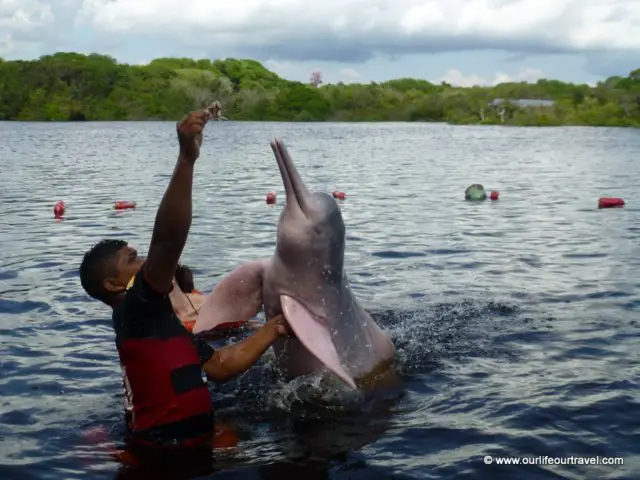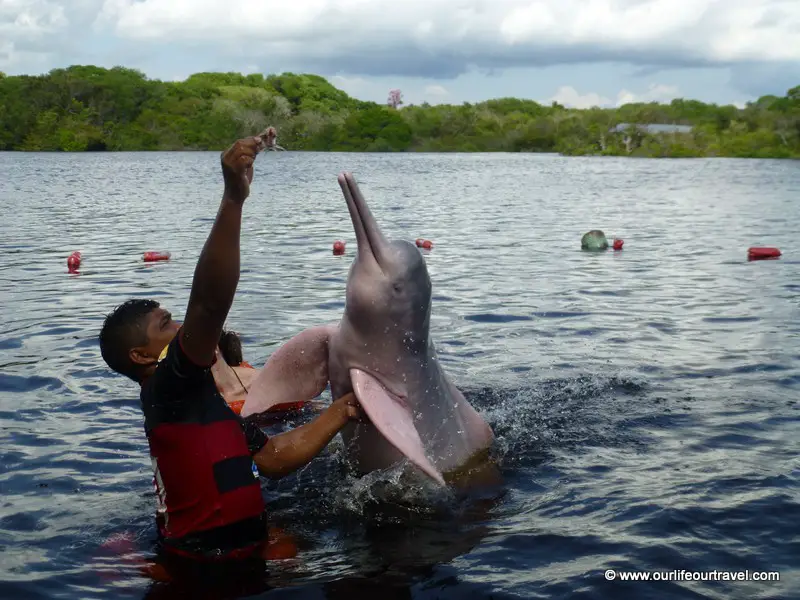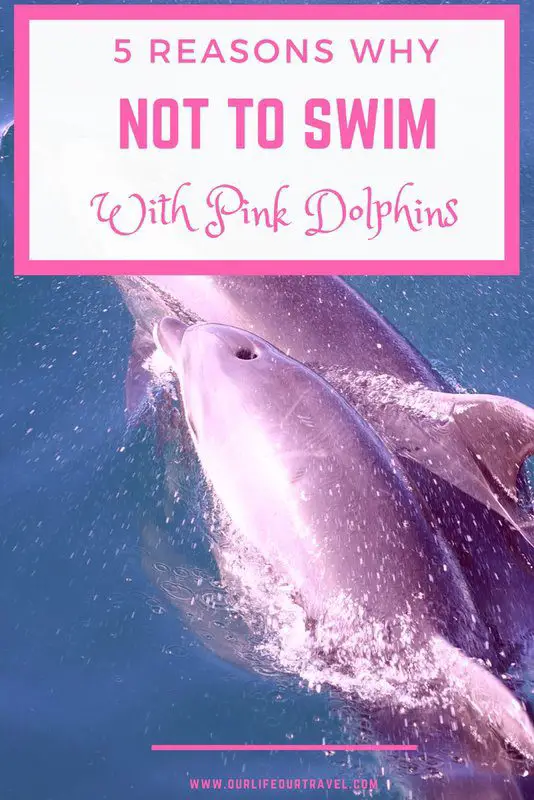Do you want to see pink dolphins? Would you like to swim with them during your visit to Manaus or elsewhere in Amazonia? We, unfortunately, did. Yes, we were disappointed after our adventure – and sadly, we didn’t do our research before we agreed on the program during our week in the rainforest in the Rio Negro. Let us show you why.

11 Pink Dolphin Facts
We collected the most important facts and curiosities about these pink river dolphins:
- the Amazon River Dolphins are the largest and most widespread freshwater dolphins in the World,
- you can find them in Bolivia, Brazil, Colombia, Ecuador, Peru, and Venezuela,
- pink-grey color,
- they can measure up to 185 kilograms (408 pounds) and 2.5 m (8.2 ft) in length,
- they can turn their head 180 degrees to maneuver better between the obstacles in the water,
- they may live a long life, even up to 30 years, but in captivity, their average lifespan is less than 2 years,
- calves are born between July and September,
- the Amazon River Dolphins have 130 teeth,
- they swim slow, 1.5 to 3.2 km/h (0.93 to 1.99 mph),
- often live alone or in small groups of 2 to 4 dolphins,
- their skin is still taken for leather.
Here you can read our detailed post about pink dolphin facts.
Where to see pink dolphins?
Pink river dolphins only live in freshwater, more precisely in the Amazon and Orinoco river basin in Bolivia, Brazil, Colombia, Ecuador, Guyana, Peru, and Venezuela. The following three countries are the most popular ones to see them.
Pink dolphins Brazil (Amazon river dolphin)
The pink dolphins in Brazil can be found in the Amazon and Orinoco river basins. Manaus and the Upper Amazon River (for example, Tabatinga) are great locations in more detail.
Pink dolphins Peru
The Pink dolphins in Peru live in the Amazon River basin. The best locations to spot them are Iquitos, the Pacaya-Samiria Reserve, and the Upper Amazon River.
Pink dolphins in Colombia
The Colombian Amazon is the area you should head to meet with the pink dolphins. Leticia is one of the bigger settlements.
Why not to swim with Amazon River Dolphins? It is on my bucket list…
Many of us would like to swim with ‘rainforest’ dolphins, especially with the pink, freshwater species. It sounds like a cool activity initially, and we didn’t have any doubts before we actually saw the location.
Responsibly meeting with animals.
We expected a similar adventure as we had in Indonesia. In Flores, we had a great multi-day excursion that included swimming with mantas, medusas, and fish. There, we traveled by boat to a location where these sightings are frequent. We spent a couple of hours snorkeling, swimming, and sunbathing on the boat while we tried to spot them in the water. We saw several fish species in their natural environment. Karol even saw something manta-like animal from the boat while I was floating on the other side. And, of course, they did not guarantee the encounter with rays.
But it was totally different in Amazonia! Probably I should have checked pictures about it beforehand…
1. Dolphins are guaranteed
“No luck needed, you will see and swim with the pink dolphins” – and so it happened. That is the first sign you should look out for! How can they guarantee the encounter?
2. A wooden platform for tourists
We docked to a small wooden pier, received the instructions and life vests, and then dipped into the water. We were standing on a platform prepared from wood attached to the pier. The water was shallow (but you still needed lifevest for safety reasons). They brought some fish to bait the dolphins. Threw two-three pieces into the river while holding some more just right next to us in the water. After a couple of minutes, the dolphins swam up to the platforms. They were pinkish grey and rather small. The ‘crew’ grabbed them (!!!) while giving you time to touch them or take pictures. I felt like in a circus. I didn’t want this. It was exciting to see dolphins from so close, but not in this way. Never again.
3. Overfeeding and declining abilities in the wild
There are several platforms like the one we visited around Manaus to swim with dolphins. As you can imagine, a significant amount of tourists visit them, and with the baitfish, the dolphins are overfed. Why would they hunt for food when they get it for free without much hassle? The dolphins became dependent on the human trying to make money by tourism.
4. Governmental regulations
To mitigate the problem, the government limits how many days the tour operators can accept tourists and feed the animals. Well, that’s at least a step on the way to ensure they are still capable of living on their own.
5. Fishing
The latter cause is unrelated to the tourist activities but affects their population significantly. Fishing for fish species like the tambaqui and the pirapitinga causes harms to the pink dolphins too. They are often attracted to the traps and strangles to the nets and lines. Instead of freeing them, local fishermen deliberately killed them for consumption or to place their carcass as bait. Currently, it is strictly forbidden by the government, yet it didn’t eliminate the problem, just reduced it.
If you still decide to take a tour, choose responsibly!
Watch the dolphins when they are swimming freely.
During our boat trip from Manaus to Tabatinga, we spotted these gorgeous pink creatures several times from the deck. They jumped and swam along with the boat, freely and joyfully. Be responsible and observe them in their natural habitat without forcing them to come to you.
Give a second thought and do your research before you sign up for this adventure.
Travel Resources
There is nothing better than a relaxed holiday. To ensure your rest, make sure you reserve and book your accommodation and transportation in advance of your trip.
- Book a small group of private tours with us at amazinglapland.com to make your experience magical in Lapland.
- Don’t forget to insure yourself during your travels: SafetyWing. Check out their policies HERE. It also covers several virus-related expenses.
- Look for the best prices on flight tickets, hotels, and car rentals: Expedia
- Car rental: SIXt
- Accommodation: Booking.com, Agoda or Hostelworld if you travel on a budget. Don’t forget that you can search for Apartments also on Booking.
- Activities: GetYourGuide
- Opinions on hotels and restaurants: TripAdvisor
- Was your flight canceled or delayed? Get up to 600€ back with the help of Compansair!
About the Author

Katalin
Katalin is a Lapland-based outdoor enthusiast who loves hiking, road-tripping, and traveling with her family. She spends her free time far away from civilization in one of the national parks around the world, explores off-the-beaten-path places, or hops on a road trip with her kids in an RV.
Read more about her adventures and the blog.




I have swum with them somewhere else, non touristy, and it was just us in a little boat, no guarantees, no feeding or touching, and it was perfect. They did come to us but completely of their own accord, and one swam between my legs. I won’t say where because I don’t want it to become what you’ve described
We’re glad you had such a pleasant experience and appreciated not disclosing the location. Unfortunately, it gets less sustainable when EVERYONE wants to touch the dolphins, and there are others who gladly accept the money for guaranteed sightings.
We were much happier observing them from the ferry day by day, then during this dubious ‘experience.’
Thank you for taking the time to make this post making us understand why we shouldnt do this!
Watch the dolphins when they are swimming freely <3
Thank you for sharing !
Thanks for this 🙂 We often forget that preserving nature should be more important than the photo op or our “bucket list”.